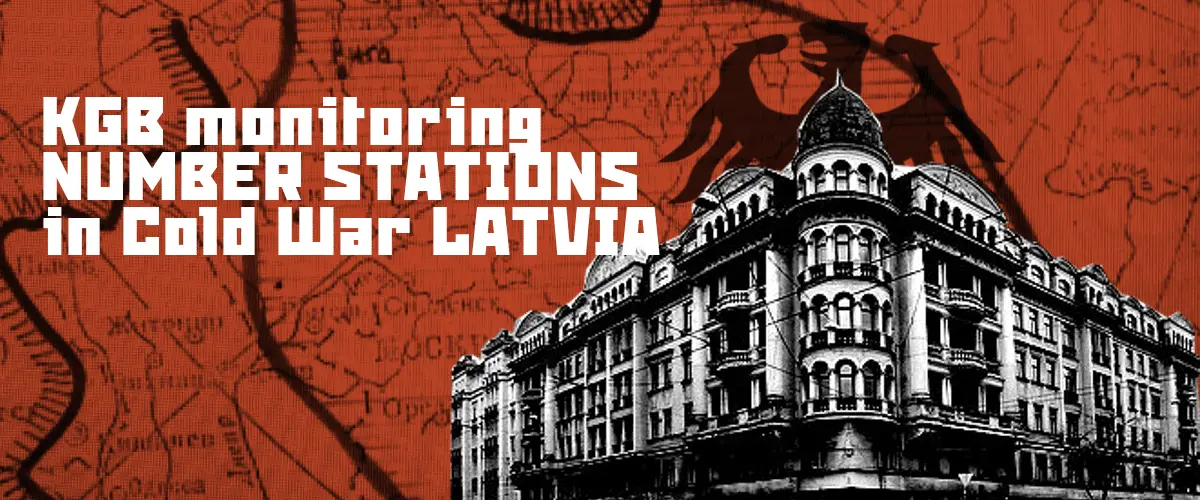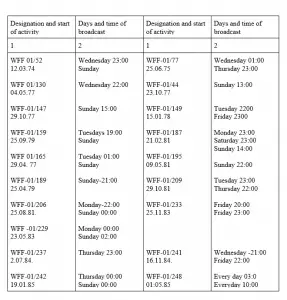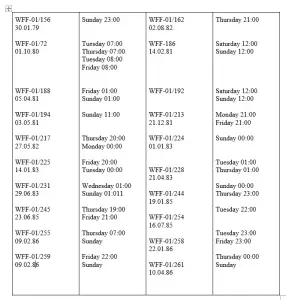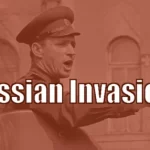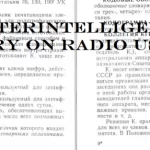Numbers Stations over Soviet Latvia: KGB counterintelligence monitoring of Western intelligence radio transmissions. Exclusive from the KGB archive
by Māris Goldmanis[1]
mg.hist
Introduction
During the fast-shifting events of 1990-1991 in the Soviet Union, it was a challenge to keep and preserve the most important documents from the Committee of State Security (Комите́т Госуда́рственной Безопа́сности) KGB. Latvia was one of the few countries managing to do this because of unusual circumstances, one large part of KGB agent messenger personal files and their messages were preserved as well as a large part of KGB operative documents containing the information about the KGB’s work in Latvia during the 1970s – 1990s. The work of the Soviet secret service was not just political control and struggle against the various forms of anti-Soviet dissent, their responsibilities also included the fight against criminal activities, as well as searching for Nazi war criminals. However, in our case, we are interested in one of the main aspects of the KGB work within the Soviet Union – counterintelligence.
It is often mistaken to assume that if we would start searching the archives of the intelligence agencies we will find indisputable proof that an agency, like CIA or KGB had used numbers stations[2], a one-directional shortwave radio broadcast of a string of encoded numbers directed to operating agents for espionage in another country. While it’s possible, the documents that clearly confirm the use of numbers stations as a tool for intelligence are the counterintelligence documents. The counterintelligence duty has always been to monitor radio waves for any signs of adversary intelligence activity. Just as radio amateurs or numbers stations loggers, their work was and still is to monitor the radio waves, writing down every transmission, its frequency and time, however, while for civilians this is merely a hobby – for counterintelligence the radio signal monitoring is a state duty and in the end, this effort had to result in the capture of a foreign agent and disruption of the intel operations. The CIA and FBI published several documents already on this topic and they were described on our site before.[3] Now it’s time to look at the KGB counterintelligence effort.
The Case 51st
The Second Main Directorate of KGB was responsible for counterintelligence operations and worked in all parts of the Soviet Union. In Latvia that was occupied and annexed by the Soviet Union in 1940, counterintelligence was very important, as Latvia was the Soviet Western rear. CIA and SIS had staged intel operations in the Baltic States from 1946 onwards, for instance, “Operation Jungle (Operation Tilestone)”[4] that involved heavy use of radio communications. There were other such efforts since then, and as radio technology became more advanced the efforts of monitoring the radio waves became more detailed. The focus of the study is the 51st case from the Latvian State Archive (Latvijas Nacionālais Arhīvs) 1st Archive Group/Foundation, second list (Second Main Directorate). From 2019 the National Archive in Riga grants access to historians to the KGB operative cases.[5] This particular case was discovered when the author of this article was doing a study for another history project.[6] The permission for viewing and studying these documents was granted to the author with a recommendation from the museum “Jews in Latvia”[7]
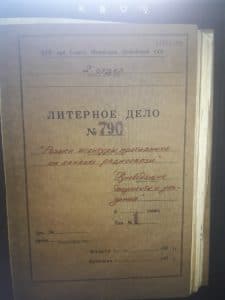
The case consists of 184 pages and covers the time frame from 1979 to 1987 and is labeled as “Monitoring for adversary agency presence in the radio channels. 1st volume. Ruling instructions and documents”[8] The case first contains long instructions about the foreign intelligence use of numbers stations, how to monitor them and apprehend the agents using them. Then follows the most interesting part – the documents of monitoring the signals, where every transmission was fully documented and includes even a tape of recordings and maps of how far into the USSR these transmissions were heard. Additionally, there are also documents of the KGB keeping a check on radio amateurs in Latvia – as well as some radio amateurs in the Western block that was under Soviet watch. The documents are in Russian. This publication will fully describe this very unique case, without mentioning any sensitive personal information. The article will also include some scanned images from the case.
The Case opening
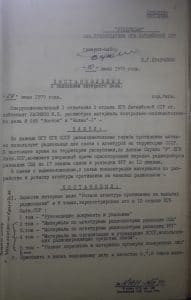
In 1979 June 29, in Riga, the case was opened by orders of the deputy chief of the Latvian KGB general major Evgeni Grigorievich Kravchenko[9] as part of control-monitoring case Nr. 685 “Vostok” and “Volna-1” where it was stated that it has been found that within USSR adversary agencies are using one-directional broadcasts using 17 lines of communications from the US and 12 lines of communication from the German Federal Republic[10]. One-directional broadcasts are the intelligence language term for numbers stations. Meaning a coded signal is sent from abroad and does not require return communication from the agent. In the past, the agents who infiltrated the foreign country were required to take their own transmitters with them to send coded messages back to their countries of origin. Since in some cases the agents were captured with all the transmission material and were even forced to send fake messages back to their employers or as in Syria the source of the back return communications were eventually found (Eli Cohen case[11]), the intelligence agencies now started to send one-directional messages where orders or messages were sent to agents only. The agent then had to reply by using other methods such as dead drops and secret meetings. While this method was still prone to failure it was safer than having two-sided radio communications.
The Service-R (a special service of the Second Division for surveillance) that was responsible for surveillance had gathered the data on these transmissions and as a result, this case was created. The case was opened and signed by the chief of operations of the first department of the second directorate of Latvian KGB I.V. Kasimov, chief of the first department and second directorate Major V. A. Bauers the chief of second directorate colonel B.J. Šteinbriks.[12]
The origin of this case can be traced a year earlier to a meeting on the 30th of August 1978 between B. J. Šteinbriks and one of the chief engineers of the “R” service who had determined the presence of the adversary radio signals discovered in the counter-intel operation “Dzintars” (Amber) in 1976/78. The operation resulted in the arrest of agents “Stiron” and “Nero” and criminal activity of “Inspector” and “Lopuhovo” had been thwarted, who was suspected in aiding the adversary. [13] The monitoring events called “Delta” and “Bars” determined the efforts of the adversary showed that monitoring efforts did not fully comply to the standards of the KGB and the use of radio signals as a proof for the crime of “treason to the fatherland” and proof for being recruited by the foreign agency had not been used conclusively enough.[14]
Because of these shortcomings with evidence, the order was given to solve these issues and to start a comprehensive study on the Western radio centers and radio broadcasts. On the 31st of August 1978, major-general chief of KGB in Latvia Longins Ivanovičs Avdjukevičs[15] had made a plan for service “R”. It was stated that it was known that within the USSR foreign agencies could send 152 one-sided communications, within Latvia 62 communications were being monitored – 36 from West Germany and 26 from the US. The adversaries were also capable of using VHF and UHF range for close communications. As Latvia was constantly visited by foreigners and about 200 diplomats, these close-range communications also served as objects of attention. The civilian ports in Riga and Ventspils were also objects for smuggling. The foreign agencies also were using Western amateurs radio operators to make contact with Soviet amateurs to gain information from them.[16]
Since Latvia as a part of the USSR was considered as a border area with many important military personal and objects (Riga was the center of the Baltic Military District) in the period of 1978-1979, Service-R was ordered to conduct a thorough monitoring of the radio communications and intercept possible personal radio communications that might be harmful.[17] The responsibility of signal triangulation and surveilling special diplomatic visitors and guests were also added to Service-Rs remit. Latvia during USSR was not actually entirely closed to foreigners, a large Latvian exile community often could get entry into Soviet-occupied Latvia, however, every such visitor was on a KGB watch list as he could be either a suspected spy or if the person was good material he could be recruited to spy on Latvian exiles. In practice – the foreign visitors who were deemed suspicious had to be observed and if their actions coincided with the time of the radio broadcasts – then that person would be suspected to have received these signals. The instructions also noted that it’s important to check if some political or military events could affect the broadcast times.
The KGB’s main monitoring objectives in Riga, the capital of Latvia, were as part of the event “Bars”, to observe foreigner activities at the hotels “Rīga” and “Latvija”, the airport in Riga, the Dome Concert hall and the ports in Riga and Ventspils. The event “Delta” was aimed to regularly eavesdrop on foreigner technical property.[18] As well the checks were required for the radio amateurs, official members of DOSAAF[19] (Army and Sports Club) radio club as well as unlicensed ones to determine if they were making contacts with Western counterparts. The next important assignment was the event “Kordon” (Cordon) that was tasked to create radio interference in areas where secret activities were carried out. And finally, illegal radio equipment had to be found and confiscated.
The description of the “one-directional” broadcast was explained in the following instructions. The document stated that adversaries sent encoded messages that can be received by a simple radio receiver and the agent we’re using other means for return communications. Instruction named the advantages of such messages:
– The message can be sent almost every time of day and almost at every geographical range
– Since the agent is not sending message personally, he is safer and is not required to use and handle sensitive radio transmission equipment
– It eases significantly the training for radio equipment.[20]
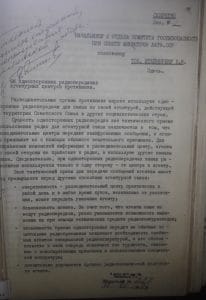
The instruction further states in the 1960’s when the adversary just started to use one-directional radio messages, they did that in “telegraphic mode” (A1) using Morse code, however, such method was hard to master for some people and to receive Morse code properly special radio equipment was needed. As for the given time, the document stated that the US used just one channel with Morse code. In 1961-1962 the US started to send improved “tonal telegraphic” (A2) signals that would be received on usual radio receivers. Later the adversary started to use “telephone mode” (A3) (in modern language AM, USB, LSB mode)[21] where the operator is sending numbers in English or German. Such a method eases the agent training even further, and A3 mode can be received on a commonly available shortwave radio receiver. The instruction further continues that in recent years the signals were no longer sent in full AM, but rather in USB and LSB that required either a special radio receiver or normal radio receiver with a changed schematic. Usually, the message was sent on two frequencies at one time, so the agent could choose the best working frequency for his conditions. [22]
In the first 5-10 minutes, the station sent an ID signal, giving time for the agent to prepare for the reception. The signal can be either genuine instructions or a training message, that can be determined by numbers in the starting sequence. Also, the agent ID is determined. If the number does not correspond to the agent, he can turn off the broadcast then. If the agent is poor at learning Morse code, it’s being sent at a slower rate. The message is usually repeated twice in an interval. The main issue for the agent is to find appropriate radio receivers as well as issues of reception caused by interference.[23] In the Soviet Union where the radio industry had created radios with often limited reception of frequencies, or simply because of the deficit, getting an appropriate radio was an issue. Foreign radio receivers were seen as a sign of suspicion. Modding the schematics of the Soviet radio required some skill as the Soviet electronics, while having many things in common with Western counterparts, was still based on different schematics that were not used in the West.
As a result, an agent can be comprehended by following incrementing situations: he owned the radio receiver, he adopted his life routine according to the broadcast times. Most incriminating evidence was to be obtained if an agent did not destroy the notes resulting from decoding messages. Also, note on broadcast time. Possibly the agent might have even recorded the message on tape. Another sign that counterintelligence often used against agents suspected of receiving signals was to call them on the time of broadcast and see if he would not pick the call.[24]
The service-R determined that the US and GFR were the main users of this one-directional message broadcasts. One of the main centers for sending these messages was located in Frankfurt am Main, and sent signals towards the Soviet Union and the Eastern bloc. Most heard in Latvia were operated by the CIA, while those of the DIA were heard very weakly. At the end of this description, it was concluded while these signals are to be taken into serious account, they can’t be taken as a priority for counterintelligence and should be regarded as “artistically” and used along with other methods and materials.[25]
The “Havana Moons” of the KGB
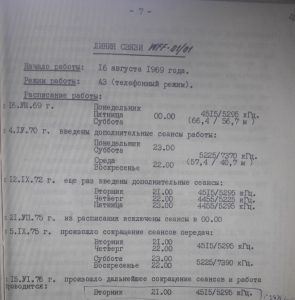
Before there were serious numbers stations monitoring groups like Enigma, there were people like “Havana Moon” who regularly published their numbers stations logs in journals such as “Monitoring Times” for the amusement of radio listeners.[26] Meanwhile in Riga, and elsewhere for the KGB, this was a serious matter. Without a doubt also the US counterintelligence did that as well. The KGB had set up secret listening posts in Riga and other places where the radio frequencies were monitored on a daily basis. The station logs were done in almost Enigma2000 like perfection or even better. But again, it was not for a hobby, it was part of securing national security.
Note: The KGB used the term “Communication Line” for what we usually understand as “numbers station”, for a single specified broadcast as WFF-01/01 and such. In general terms, these broadcasts as a whole were called “one-directional”, “one-way”. Another term used by many agencies across the world is the “radiograms”.
These were the early monitoring results:
The communication lines were given their own KGB designations.
WFF -01/01
A3 mode
Start of activity: 16. USh[27] 1969
Broadcast times:
16.08 1969
Monday
Friday 0:00 4515/5295 kHz
Sunday (66,4/56,7 m)
12. IY. 70 more broadcast times added
Monday 23:00 5225/7370 kHz (57,4/40,7 M)
Sunday
Wednesday 22:00
Sunday
12.IX 72 more broadcasts added
Tuesday 21:00 4515/5295 kHz
Thursday 22:00 4555/5225 kHz
Friday 4455/5295 kHz
From 21 UP. 75. Broadcast times at 00:00 removed
From 15.IX. 76 broadcast times were cut
Monday: 21:00 4515/5295 kHz
Thursday 22:00
Saturday: 23:00 5225/7390 kHz
Sunday 22:00
From 15. YI. 76 more broadcasts cuts
Tuesday 21:00 4515/5295 kHz
From 15. YI. 76 the broadcast schedule changed many times. It is possible that these changes from 16. 69 to 4. IV had experimental character as can be shown by the following facts:
● The following communications line used new data that must be checked at once on all frequencies.
● The used call signals 173 and 258 were then new came at a regular basis[28]
In the second period of transmissions, more broadcasts were added, but training schedules remained with callsigns 173 and 258 were still used along with new ones. The increase was tied to the agency and agent determining the best broadcast times for them. Also, it was speculated that certain US citizens that worked in the US embassy had made radio receptions tests in this period.
From 1972 to 1975 the broadcast schedule was cut short and probably was used for actual agents. The schedule was now seen as stable for agency work use and at its time of document writing, it was working with German female voice numbers.[29]
At the start of the broadcast for 10 minutes for three times the 1-10 test count was made like 258 258 258 1 2 3 4 5 6 7 8 9 0 then came the signal “Warning!” and the actual message as such follows:
Gruppen 87 Gruppen 87 Gruppen 87
Then a message of 4 digits follows.
And then stated in German “Wiederholen” (“repeat”).
The message after repeat ends with “Ende” (“over” in German).
The message was heard on Soviet radios VEF-10, VEF-12, VEF-201, Spīdola-231, and Riga-104.
The KGB listeners presumed the person who receives these broadcasts is from the USSR who had been in the Western block from 1971-1972 and had been recruited and trained, and lived in his own apartment with small or no family, while there could be a change from 1976 because of new broadcast times since he could get a broadcast time on 21:00. It was also determined that in 1977 he might have again crossed the border having received new instructions on broadcasting times.[30]
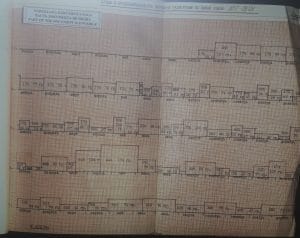
WFF-01/48
Active since: October 2 1973
Mode: A3
Broadcast times:
From 2.X.73 Tuesday: 22:00 7745/10135 kHz
(38,7/29,6 m)
From 17. Y. 77 Tuesday 10:00 10135,11273 kHz
(29,6/26,6)
These messages were sent from the Frankfurt CIA radio center and it was concluded that until February 1977 they were faked messages.
Because for almost four years 864 callsign was used, while other broadcast lines had regular changes of callsigns
From 1974 to 1975 yearly six messages were sent, such stability did not indicate an operational character.
In 1976 the same message was repeated constantly for a long time.
The agent had not been outside the USSR before 1977 when it was determined that he now is ready for receiving real messages.[31] In 1977 he could have crossed the USSR border and informed the radio center of appropriate broadcast times. Since he could receive from 1977 messages at 10:00 shows this late morning time was good for him for being either at home or work. It was also outlined that such a schedule shows he could be involved in the arts sector. One important detail is that the frequencies used by these broadcasts were not available in most Soviet radios with the exception of Riga-103 or modified VEF-12 radio.[32]
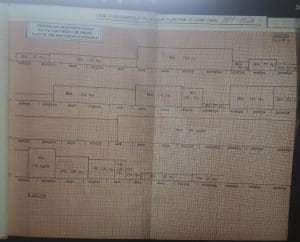
WFF-01/52
Start of Activity: March 12, 1974
Mode: A3
Broadcast times:
From 12.Sh.74 Tuesday 00:00 5225/6920 kHz
Wednesday (57,4 43,4 m)
Thursday
Sunday
From 2.YI. to 23. Y.I 1974 the broadcasts were moved 4455/6920 kHz
From 30.YI. 74. Broadcasts were moved to 3810/4990/6920 kHz
From 3.YI.75. The broadcasts were cut to
Thursday 3810/4990/6920
Sunday (78.8/60,1, 43,4)[33]
The person using this line was most probably recruited already before 1974 and this line was made for him only. The broadcast frequencies were changed once an agent sent reception reports to the center. A large number of broadcasts could determine that he was very active in his work. The 3810 kHz that is not included in any Soviet-made radio shows, he could have used a foreign radio or had modified a local one. The broadcast time shows that it was accustomed to the bedtime for the rest of his family if he had one. The 6920 kHz frequency that is poorly receivable in Latvia, shows the agent is not in Latvia but one of the central areas of the European side of the USSR. The triangulation points to an origin in Frankfurt in the GFR.[34]
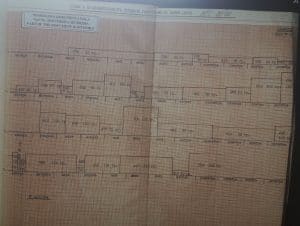
WFF-01/70
Start of activity: January 2 1975 3810,4770 kHz (78,8/62,9)
Mode: A3
Broadcast times: Thursday 23:00
Sunday 01:00
In 1977 the broadcast was changed to Tuesdays at 12:00 on frequencies 10135/11273 kHz.
Until 1975 it was determined the agent received training signals. From 1976 four-digit groups were replaced to 5 digits and now the messages became operative. The messages had a more regular character, that showed the agent’s high activity. The change of group shows that the agent received more priority tasks and the 1977 change to daylight broadcasts also shows some change in his family or work conditions. The frequencies used by the agent can only be received on Riga-103 radio or foreign radio.
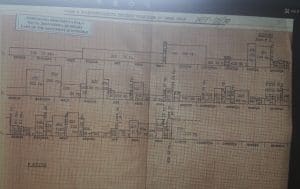
WFF-01/89
Start of activity: October 7, 1975
Mode: A3
Broadcast times: Tuesday 01:00 4022/4990
(74,6/60,1 m)
There was too little data to gather on this line, however, the good quality of the broadcast reception in Latvia does not allow me to not let this line unattended. It was determined that because the broadcasts use even numbers, the messages were for training. Also for a period of time from 1976 to 1977, the messages were ceased, indicating some problems for the agent or a prolonged abroad duty. The messages were clearly received on domestic VEF-12, VEF-201, Riga-103. [35]
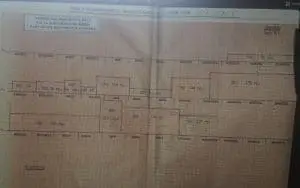
WFF-01/123
Start of Activity: September 16, 1976
Mode: A3
Broadcast times: Thursday 20:00 5770/6826 kHz (52,2/43,9 m)
Sunday 16:00 7662/10135 kHz (39,1/29,6 m)
Since the start of its activity, there had been just three messages that are training or a fake decoys to divert from other real communication lines. If they were meant for agents in training then the attention must be kept if the same line appears on new frequencies and times later on.[36] The messages can only be received by foreign radio or with modification done.
WFF-01/125[37]
Start of activity: November 25, 1976
Mode: A3
Broadcast times:
From 25. XI.76 Monday 18:00 10315/8120 kHz
Thursday 12:00 10135/11273 kHz
From 21. Sh. 77. Monday 19:00 10315, 8120 kHz
Thursday (29,6/36,9 m)
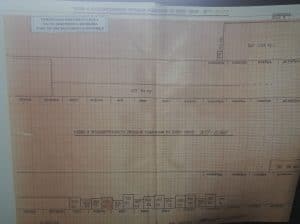
This station has sent 16 messages in one year. That led to the assumption that this line was used as an additional line for working agents. It’s possible the CIA agent had left the USSR borders and had received new training on radio messages. The 8120 kHz shows that the agent used a foreign radio receiver. It was determined that the agent might have his own summer house (dacha) or a car where he can receive these broadcasts.
For all described broadcast lines, tables of reception times, callsign numbers and number groups as well frequencies were created.
More Soviet efforts on guarding the airwaves
On the 12th of April 1979, a new plan was implemented, starting a new counterintelligence operation named “Kurzeme-79” (Courland-79) to secure the Soviet borders. The operation was to be carried out in the Latvian region of Courland, as well as in Riga and Tallinn, Estonia. The monitoring of the radio signals was also included in the plan.[38] For the radio signal reception and monitoring, the R-359 radio direction finder[39], as well as “Orel-IM2”, “Siren-P” radio direction finders were deployed and orders were given to create maps of the signal reception.[40] The Operation was to be carried out in June.
Before in 1976, the Soviets took note that a temporary employee of the US embassy in Moscow, Hayden Houston, whose main work was in the embassy in Pakistan, had arrived in Riga. The KGB determined he was doing radio reception tests of foreign broadcasts and possibly also of the Number Station signals.
Events codenamed “S.T.O.D”, “Zakaz” and “Delta” were carried out and could not determine if he was checking the number station signals. However, another surveillance team found he had special radio equipment. His radio listening showed he could have controlled the reception of WFF-01/52, WFF-01/70 and WFF-01/92. The surveillance observed him listening to the radio in his hotel room at midnight. In 1978 25 to 28 May, the H. Houston was expected to visit Riga again, however, the arrival was delayed because of bad weather that canceled his flight. By that time the CIA from Frankfurt operated the WFF-01/70, WFF-01/192, WFF-01/123, WFF-01/138, WFF-01/145, WFF-01/146, WFF-01/150, WFF-01/151 communication lines. The analysis showed that WFF-01/92 could have listened to twice as well as line WFF-01/70. Special suspicion was raised because the diplomat canceled the trip to Riga when it was clear that he will not be able to arrive in Riga in the evening on Friday, meaning it was important for him to be on time for the schedule.
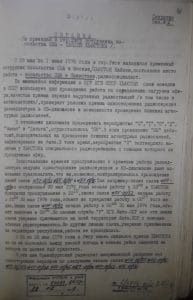
During Houston’s visit the broadcasts took place on:
Thursday 25.05.78 WFF 01/70, WFF 01/138
Friday 26. 05. 78 – no broadcasts
Saturday 27.05.78 WFF-01/92 at 00:00,WFF-01/151,
Sunday 28.05. 78 WFF-01/92 at 00:00 and WFF-01/150, WFF-01/70, WFF-01/145, WFF-01/146
Monday 29.05.78 WFF-01/92 at 00:00 WFF-01/150
The investigation concluded that Houston was interested in most part of receiving WFF 01/52, WFF-01/92, WFF-01/70 that might indicate that the agents using these stations were located in Latvia.[41]
In July 1979 the radio monitoring operation was carried out by Service-R and it was determined that following communication lines were sent from Frankfurt and Munich
WFF: 01/48;52;92;111;116;125;131;132;136;138;139;140;141;145;146;149;150;151
DMF: 01/MR
DMJN: 01/AV;KT;NQ;NZ;OV;TP
DMF/DMJ – 01/A&;EA;LA’;LU;ZD
Authors note previously unmentioned DMF or DMNJN designation communication lines (numbers stations) in the case, came either from the Munich radio center or were transmitted by another adversary country or military.[42]
Then the documents take us further to 1980 where Service-R reports that in 1980, using domestic-made and foreign receivers, it was possible to receive one-directional broadcasts from 10-13 communication links allegedly belonging to a CIA radio transmitter in Frankfurt.
As part of the operation “Kent”, 13 broadcasts that started from 1975 were monitored. It was determined that 13 communication lines worked on Mondays, Tuesdays, Thursdays with two broadcasts every time – eight broadcasts in total. On Fridays, Saturdays, and Sundays five broadcasts took place, so 15 broadcasts total.[43] Saturdays and Sundays saw ten broadcasts, while the remaining workweek only saw 13. This was natural, as agents had to work, and had more available time to receive transmissions on the weekends. The usual time for transmission was either early in the morning or late at night. However, there were exceptions, such as #25 which appeared at 19:00 on Mondays and Thursdays from 25.11.75. #144 and #146 began on 21.10.77 and was scheduled at 13:00 every Sunday (neither of 13 communication links had any daytime broadcasts anymore).
Special attention by Service-R was given to the following communication lines.
Line 77-01/48 2.10 (from 2.10.73) as it was determined from 1977 were false messages using callsign 864. From 1974 to 1975 six messages were sent. At the end of 1979 the station ceased activity.
Line -01/92 (from 17.11.75)
From early 1975, 25 messages were sent. High importance was given for uneven numbers for the three-digit callsign. From 1980 13 messages were sent and just six were operational in nature. From August to October, the same message was repeated 21 times. It was determined that possibly the US diplomat H. Houston controlled these messages.
Line – 01/110 (from 9.6.76)
In 1977-78 a large number of false messages were sent with fake callsigns 666 and 888. As in case of line 70 for agent “Agronom” the fake signals like 111 meant “Saw your signal”, 222 – “the communications with you are lost”, 333 – “we sent a package”, the communication line 110 did not seemed to be very operational by its activity.
Line 0/125 (from 25.2.1976)
From 1st December 1977 16 messages were sent, indicating the communication line was made for an already operating agent.[44]
It was determined that line 01/92,01/145,01/151 could have been connected with the US diplomat Houston as well as other US diplomats who visited Latvia from time to time. Service-R was tasked to gain more information about the dates, number of broadcasts, and determine if the station was operational or a decoy. The orders for further monitoring and analysis were made in 1981 so the monitoring continued. [45] So far, the monitoring since as early as 1978 gave only theoretical results. The agency knew the broadcast times, frequencies and message groups, but the rest was mostly based on guesswork based on logical assumptions. It just proved that the use of such communications in intelligence work was effective and yet as hard as it was shown in the documents that many broadcasts were just for training. The counterintelligence, however, could not dismiss all this work as irrelevant – the signals and their behavior had to be monitored until there was a certain clue that would allow them to apprehend the foreign agent. For counterintelligence, the capture of one agent is an achievement that is worth years of careful work.
Radio Amateur Broadcasting more than just a hobby for some people
Another aspect for counterintelligence that required radio monitoring were the radio amateurs. Licensed or unlicensed they could contact Western amateurs and vice versa. Even casual talks about social life issues were seen as a threat to Soviet national security. In 1980 the KGB received a large list of radio amateurs from the US and GFR who were known to have made contact with Soviet citizens in Latvia.[46] The large list of four pages will not be published as it contains the callsigns, surnames and living locations of the Western radio amateurs.
Then the KGB also made inquiries to local KGB messengers who were within radio amateur circles. Agent “Z.V.M” made a meeting with junior colonel Leons Gailišs in a hotel Latvia in Riga, on November 10 1981. The agent told me that anyone can be a radio amateur even when not a member of DOSAAF – the Volunteer Society for Cooperation with the Army where radio amateurs were officially registered. With appropriate radio and technical skills, it could be even a school student. Since the official Soviet radio magazine “Radio” published regular schematics for homemade receivers and transceivers it was certainly possible. The only issue was the deficit in all goods including electrical parts in the last decade of the Soviet Union. The foreign radio amateurs could not send QSL cards to the Soviet Union without the Club’s permission, however, if they did so, these cards were checked at the Soviet post office control. It seems that the large list of foreign radio amateurs was either made by this agent “Z.V.M” who observed their activity and a part was made from their sent QSL. [47] In the next meeting Z.V.M informed the KGB about the specifics of radio amateur activity in Ultra High Frequency and the KGB named one Latvian radio amateurs on whom he should eavesdrop.[48]
1982… the monitoring continues
In 1982 the operation concerning adversary radio signal activity was called “Shtorm”. In Riga, radio surveillance was done in several areas, but with no conclusive results as some areas of the city were not fully covered. It was asked to do similar activities in other cities of Latvia as well.[49] The next phase was scheduled for 1983. The radio listening posts were located in Riga suburban areas – Imanta, Ķengarags, Bolderāja, and Jugla. The surveillance also took place in Ventspils and Liepāja which contain important ports and military installations in the cities and surrounding areas. The KGB was also worried about new advancements in VHF-UHF radio amateur equipment that allowed the possibility of sending fast and quality morse code messages. Baltic radio amateurs were suspected of using VHF-UHF to make contacts with counterparts in Scandinavia and Central Europe. The KGB sent an inquiry within its departments, should amateurs in these band ranges be monitored.[50] The answer came that Service-R only looks at the HF or shortwave bands and during “Shtorm” exercises no suspicious results were found on the VHF – UHF band.
In 1984 February, new results came in about the adversary radio signals. The WFF designated communication channels were still broadcasting during the height of the Cold War. The surveillance started to bear results as the agency document stated that some agent recipients of these stations were arrested. WFF-01/43 belonged to the US agent “Technician”, agent “Mexican” used WFF-01/71 and WFF-01/112, “Agronom” used WFF-01/70 and “Sargent” WFF-01/97 who received messages from Frankfurt.[51]
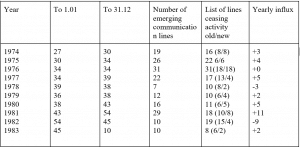
The table shows the activity of the adversary messages, and it shows the activity dropped towards 1984. The count of messages in the first two columns also included false messages.[52]
The KGB surveillance concluded that the CIA is using many fake messages only stations to divert attention from operative message stations. In 1976 January in four days, three new communication lines were made 01/96, 01/97, 01/98. Line 01/97 was made for agent “Sergeant” while lines 01/98 and 0/91 ceased activity after 1-8 months. A similar event took place in April 1976 when in six day time three new stations started to broadcast – 01/04, 01/05,01/106. 01/104 and 01/106 ceased activity after two weeks and two months. 01/05 was still active. Some stations as 01/147 first sent fake messages and then in 1977 became operational.[53]
The training stations caused special interest in analyzing how the agent was trained for operational activity. As training lines were considered:
01/96 – worked from 27.01 to 20.02 76. on Tuesdays, Wednesdays and Thursdays at 17:00 Moscow time – 14:00 GMT time. The messages were sent from Frankfurt am Main and allowed to send messages at the range of 1000-3000 km. Messages were sent in one side A3 mode (USB). In further time for the agent the operational line was created, either 01/105, 01/110, or 0/111 (from 12.06.76).
01/99 worked from 26.02 to 10.03. 76 on Mondays, Tuesdays, and Fridays at 18:00 MSK (15:00 GMT). Radio center used frequencies 5150 kHz, 6375 kHz, 6860 kHz, 6920 kHz, 8120 kHz, 11238 kHz, 11283 kHz, 13590 kHz, the range of broadcast was 900-3500 km.
01/100 was active from 21.04 till 08.05.76 at frequencies 4990/7320 kHz with a range of 1000-2500 kHz
01/104 worked from 21.04 till 08.05.76 on Wednesdays and Saturdays at 21:00 MSK (18:00). 4990/7320 kHz, with a range of 1000-2500 km.
01/109 the broadcasts took place at 5, 8 and 12 July 1976 at 22:00 MSK (19:00 GMT) at 11274/12285 kHz with a range of 2500-4000 km.
01/114 the broadcasts took place on July 15 at 22:00 MSK (19:00 GMT) from 17 July 1976 at 02:00 MSK, (23:00 GMT), at frequencies 7320/8660 kHz. The range was 1200-2500 km.
01/119 the broadcasts took place at 7th,8th and 9th of August 1976 at 03:00 MSK at the frequency 3860/4022 kHz with a range of 200-500 km.[54]
01/121 the broadcasts took place 24th to 27th August, daily at frequencies 8120/7662 kHz at August 28-29 at frequencies 8120/10135 kHz. On August 31 6376/10315 kHz and September 2 1976 at frequency 10135 kHz. All broadcasts took place at 18:00 MSK (15:00). The frequency was possible at 1100-3000 kHz.
01/137 worked at 12,15 and 17 August 1977 at 14:00 MSK (11:00 GMT), at 14430 kHz/16993 kHz with a considerable range above 3000 km. All messages contained “481”’ Gruppe 90 2082…5275. Early in August 1976, the same messages were sent on 01/120. That indicates that 01/137 was a training station.
In 1978 two agents took training from one-directional messages.
01/154 7 and 14 November at 21:00 MSK (18:00 GMT)
01/155 9 to 16 November at 21:00 MSK (18:00)
After 1978 no more new training lines were created. It was considered that the adversary cut short the training times, prolonged the activity for training lines for 2-4 months such lines in 1979 were:
01/157 worked from March 23 to May 4, 1979
01/158 worked from March 24 to May 5, 1979
01/160 May 19 to September 29, 1979
01/161 from June 20 to October 31, 1979
01/168 from February 5 to March 25, 1980
01/169 from March 7 to May 23
01/175 from October 25 to December 13, 1980
01/184 from February 4 to February 15, 1981
01/210 worked from 2.11.81 to 7.04.82
01/211 worked 3.11.81 to 6.04.82
The broadcast times of these training stations had to be checked with the times of suspicious Latvian Soviet citizens leaving the USSR and returning.[55]
The 1984 report also concluded that the broadcast times and frequencies also were determined by the technical capabilities of adversary radio centers, as well as seasonal propagation changes. Since 1972 3-31-07 the A3j or single sideband mode was used with first such station 01/133, and then such broadcasts continued till 1974. From 1976 to 1977 there was an increase in the activity with 8 and 5 communication lines beginning their work.
However, the A3j as a single sideband signal could not be received on a usual shortwave receiver, not on most domestic radios, only with special modification or on foreign special receivers. Such limitation allowed the KGB to determine who was to be suspected as an agent. Another issue was that a special antenna was required and needed to be assembled or sent from abroad. Because of that, the adversary moved back to the usual telegraphic A3 mode (AM) and just one transmission 01/147.[56] Until 1979 all one-directional messages were sent to Frankfurt am Main by both the CIA and the DIA, however, later in time, the DIA started to use a new radio center in Wittlich GFR. From the middle of 1979 on all operational lines of 01/ from May to November, the frequencies were changed because of seasonal changes.[57]
The KGB monitors created the designations WFF-01 for CIA broadcasts and WFF-02 for DIA stations. From January 1977 of 34 communication lines 16 were considered operational of them: 01/01,01/15,01/48,01/52,01/70 (“Agronom”) 01/79, 01/80, 01/83, 01/92/,01/97 (“Sargent”) 01/105, 01/110, 01/111/,01/112 (“Mexican”) 01/116, 01/125.
In 1977, operational line 01/112 ceased activity. From the new stations, just one 01/129 was experimental (the broadcast was on two frequencies sent from Munich radio center of the GFR intelligence.), while line 01/137 was for training. The fake messages were considered to be 01/128, 0/130, 01/131, 01/132, 01/136, 01/139 and 01/140. At the end of 1977 20-23 operational stations were active.
1978 was described as a “year of minimal activity”. Seven new communication lines appeared, of which only 01/149 and 0151 were considered operational. 01/152 and 01/153 were seen as decoys and 01/154 and 01/155 were seen to be for training purposes. During the year eight stations ceased activity of one 01/01 which was operational.[58]
In 1979, the operational line 01/48 ceased activity. In 1975, another operational line 01/83, changed to the Athens Radio Center and to the Radio Group WAF-02.[59] The new lines 01/157, 01/158, 01/160, and 01/161, were considered for training purposes, 01/159, 01/162,01/163 and 01/164 were considered as operational.
At the start of 1980, 22-25 communication lines were operational.
From early 1980 the Frankfurt radio center used 22-25 communication lines. In 1980, 01/15, 0/116 ceased activity. It was not ruled out that lines 01/79 and 01/80 again moved to the Athens radio center. The 01/116 line recipient was considered to be located in Poland. New operative lines were 01/173, 01/174, (in 1981 01/187 line became operational) and 01/79. The average number of broadcast lines was 21-24.
In 1981, the Frankfurt radio center became more active. Eight communication lines, 01/198 – 01/204/ 01/208, were considered experimental. The broadcasts in English were thought to come out of Athens.
New operational lines that became active in 1981 were 01/189, 01/190, 01/195, 01/206, 01/209, 0/125, 01/136, 01/151. It’s not ruled out that because of operation “Cascade-2” some stations ceased to exist or others moved to other channels. The common number of broadcast lines moved up to 26-32.
In 1982, the operational lines 01/110, 0/111, 0/128, 01/139, 0/140 ceased activity. One line 01/217 began new activity.[60]
In 1983, the Frankfurt radio center used 25-30 operational messages (at the end of the year 47 communication lines were used).
The results of the 1984 study concluded that out of 47 working communication lines, 16 of them possibly were directed towards Latvia named as follows: 01/52, 01/70, 01/97, 01/132, 01/147, 01/149, 01/159, 01/162, 01/164, 01/173. 01/189, 01/206, 01/209, 01/213, 01/217 and 01/228. The monitoring of WFF-01 family stations (CIA) showed that the adversary had learned from its past mistakes and had made more efforts in hiding his broadcasts. The training callsigns like 111 and 333 were no longer used to make it harder to determine what is a training signal, what is a decoy signal and what is operational. [61]
The Service R in Latvia made the decision to systemize all 16 one-sided broadcasts that were considered to be sent to agents in Latvia. However, this was seen as a complex and difficult issue since monitoring all 16 stations at once would be an issue of human resources and time but these same stations were also monitored and reviewed by the main Service R division in Moscow, Mensk (Minsk), Kyiv and other places and Riga surely received some data from them too. Instead, the Service R concluded that the key details needed to be sorted out for all 16 stations and then a choice needed to be made for which station deserved the most attention.
These details were:
– The start of the activity
– The time when an agent established contacts with an adversary agency
– The start of operational messages
– The start of agent active operational activity
– The length of the period of sending fake messages
– Possible period of an agent being sick
– Being on leave or being outside the USSR
– The signal length for sending the messages
– The operational actions of the station sending the communication line
– The list of frequencies used
– Type of radio receiver used for receiving the broadcasts
– The amount of radiograms of 50 groups, 50-100 groups, more than 100 groups
– possible message content, indications of the possible meeting place and dead drops
– The times of messages.[62]
All these details were gathered and conclusions were made from them but they couldn’t be taken as fully accurate. The insights and assumptions gained were still taken into account in order to apprehend adversary agents as the report once again concluded. As said before, the KGB counterintelligence purpose for listening to these broadcasts was not a radio amateur hobby, they saw these signals for what they were and rightfully saw them as a threat to their national security. The other side who sent these broadcasts from West Germany also was very well aware of this and as the report shows, they did their own efforts to outsmart the KGB counterintelligence.
At the end intelligence work is a complex game between intelligence and counterintelligence. Usually, the round always ends with a win for counterintelligence, but the question of how long it takes to halt an intel operation is vital for the intelligence agency. While Service R still monitored and analyzed these broadcasts, the ones who used for their operational tasks could have done some harm for the Soviet nation, and even when one or two were caught and arrested, there were always a few more to catch. Not all used the radio broadcasts, but what sounds like “ghosts” for some people on the radio for the KGB – it meant that there was adversary activity and the Soviet Union was in danger.
How far can the danger be heard?
Service R created many radio listening and triangulation points across the Union. Their main concern was the Frankfurt radio center that could send messages in a straight line towards the European side of Russia. As well as there were other such radio centers from other places in West Germany, France and Greece. The WFF-01/147 started activity from September 29, 1979, and could be received in Riga, Brest, Kyiv, Mensk, Moscow, Odesa, Rostov-on-Don. KGB also had listening posts in Eastern Bloc countries and KGB sister agencies also had their own radio surveillance teams. Special reception range maps were drawn to show its signal range. It was done to determine in what cities of the Union the agent could be located in. The WFF-01/147 used frequencies showed that the signal range was 1000 km within the USSR, while outside it in the Eastern block the reception was poor. The one-sided messages took place at 15:00 Moscow time, to one-two frequencies at the same time. (Up to 30.01.82 radio messages were carried out in at 11:00 MSK)
From 26.02.82 A3 telegraphic (AM) mode was replaced with A3j (SSB) mode.[63] From April 18, 1981, the station started to use the training signal “888” that could mean “no tasks for you”. From April 18 1981 the radio center changed four times the frequencies likely to adjust times when an agent again entered the operational phase. After a year and a half, the broadcast time was changed to 15:00 to allow for more time for the agent. Since April 1981 the station didn’t use any longer its training call sign and new had even numbers were used in the new one which indicates a switch to an operational character. [64]
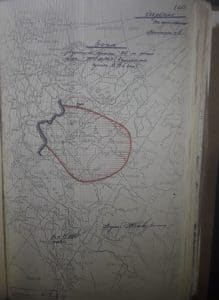
WFF 01/164 became active from August 29, 1979. Now (in 1984) the messages were broadcasted at 00:00 MSK winter time. The study concluded that the signal range is 1000-2000 km within the European side of the Union. During daylight time changes in summer, the schedule was adjusted to it.[65] Such action made the KGB assume that the agent is located in between the Moscow time zone and the Central Siberian time zone, possibly in Northern Russia.
From 1981 onwards the WF-01/164 radio center no longer sent 888 with its messages, and operative messages were sent from the end of 1980. The study of the callsigns shows that the sign of the operational message is in the third number. From November-December 1981, they changed the frequencies three times. The number eight in the call sign used – 658, 838, 978 – was considered to be used to warn the recipient that the frequencies will be changed.
The WF-01/164 also was inactive for long periods of time: May-June and November-December, 1981; July-September, 1982; December – April 1983, when the agent was possibly off duty. Also, it was possible that the second uneven number was a sign that the message is of an operational nature.[66] However, since the number eight appeared more than usual it was suggested that it could have been a training signal number. The frequencies used 10135 kHz and 11237 kHz show that the agent used a foreign-made receiver.[67]
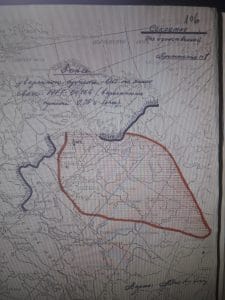
The WFF-01/173 signal from Frankfurt since October 3, 1980, was broadcasted twice a week on Wednesdays at 23:00 and Saturdays 00:00 (Moscow winter time). The station was considered to be received in the Northern and Central parts of the Union. Most important cities including Riga were in the zone of reception, as shown by monitoring results outside the Union. The station changed frequencies often and these changes came together with the KGB counterintelligence operation “Kaskada-2” and possibly did not have one agent tied to it, but rather was just an imitation of operational activity. [68]
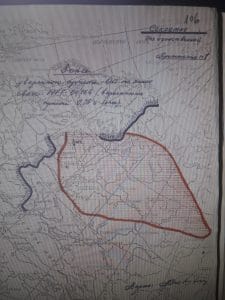
At the start of May 1983 after daylight savings, the radio center again changed frequencies and broadcasted at 6373/7376 kHz that first transmitted on 23.08.82. From December 18, 1982, onwards the schedule was changed, possibly to adjust to the needs of the agent. From August 1982 the frequencies were moved towards closer to radio amateur bands so they could be received on many domestic radios. Later many other frequencies were used that could be received on domestic radios. When analyzing the callsigns it was noted that the first digit used an uneven number, in second even and in third – numbers like for example 2,4,8,9 [1] and therefore it was presumed the messages were of operational nature. Beginning August 1982, the line WFF-01/173 started to send messages with callsigns 111 and 999 that were presumed training messages.[69]
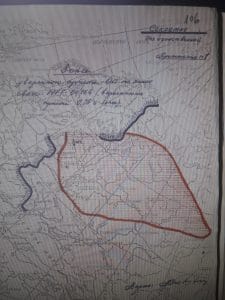
WFF-01/206 transmissions began on August 25, 1981, and were sent on Mondays at 22:00 and Sundays at 00:00 on Moscow winter time. Seasonal changes took place in November and May. The analysis of the station showed a high probability that Latvian or Lithuanian SSR[2] would be the location where the broadcasts were sent to, because of the very high signal strength. [70]
From 30.01.1982 onwards the radio center made a swift change of the working frequencies. The radiogram used callsign number 782 . From 11.12.82 the female voice sending the numbers was changed. The radiogram now sent new callsign 332 with 2 being an even number meaning it could be an operational message. There were no messages sent in the time frame between August-November 1981, December 1982 and January 1983, that could have been connected to a possible delay of activity because of technical changes in the radio center. During new transmitter tests for callsign, the number 7 was used as the third figure (057, 267,677) indicating the testing nature of the new frequencies. The frequencies sent by this line were receivable on domestic radios.[71]
The Prime Suspects
Until now, the KGB Service-R only mentioned a very few cases of real agents being captured by this evidence and these cases were not documented in much detail.
Then finally in 1985, a large list of suspects was added to the case. For reasons of data protection, their names and surnames will not be mentioned here. This list of suspects, however, was not based on radio reception, but on people sending communications back to the West. These people were known to send post messages to people in West Germany, the US and other places from various places in Latvia, Riga, Cēsis, Jēkabpils, Limbaži ect. For the most part, these people were mainly relatives of the exiles in the West, however, these KGB considered all these as suspects. The agent could have sent back a coded message in a letter of a postcard or a hidden document. When the KGB found the content of a letter suspicious, it was then needed to arrange further surveillance of the person, and when that person was reviewed – one of the questions was – where he works, at what time he is at home, what radio he owns, and when the person was abroad and if possible when he was sick.
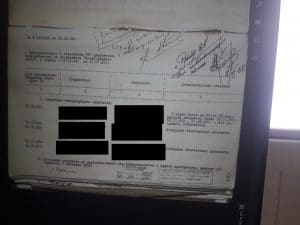
That was the point of all past collected data – if there is a suspect who fits to some of the details connected to some of the active broadcasts – further surveillance had to be carried out. Also sending QSL reports for Western Stations like “Voice of America” by some short wave radio DX enthusiasts was seen as a criminal activity. Other examples leading to suspicion were letters and documents with no real content, some strange markings or a signature not matching. When some US citizens sent blank letters to the US, this was considered a reception test, as the KGB discovered some Americans sent the blank envelope to themself. Why? Some other postcards in English were sent to France, with the word “France” in Russian. Someone had sent a message to the Netherlands with a “stylized signature”. It would sound to be very paranoid handling of these occurrences, but all that seemed out of normal had to be checked. One document sent to Canada really had included a cipher and was written on thermoactive paper. Now that was a reason for concern. Other messages were simply written in poor English. Another example is a greeting card to Germany. In the German language, the word Riga had it written with the letter Ī (Latvian Rīga) crossed out. Or if the text in a foreign language had it written as Rīga.[72]
Eventually, maybe just a few of these people were actually involved in any intel activity and some might have been removed off the list on the spot, while others, however, might have been kept on, and marked for further surveillance and some even pressed to cooperate and become an off rank agent for KGB.
1985… 1986 not yet perestroika, the monitoring goes on
The new changes in Soviet leadership occurred in 1985 after years of Brezhnev, and the short rule of Andropov (a long time KGB chief) and Chernenko’s lack of management. By views of some authors, the move by Gorbachev’s towards reforms and warming of relations with the US were not caused by his own democratic beliefs, but rather by failed weapons programs like the Polys spacecraft that was meant as an answer for the US “Star Wars” program and in general by the arms race initiated by Reagan which put a huge burden on the Soviet economy.[73] The Chernobyl disaster and the failing war in Afghanistan pressed towards this further. By 1985 the Soviet Union had created one of the largest and most effective counterintelligence services in history as well as a strong foreign intelligence. The KGB was a grand titan that acted as Sword and Shield of the State and the Party, and it was very good at it. However, the Soviet military complex was failing, the industry and economy were failing, the society despite all efforts of the KGB political division had become more influenced by the West and itself was inert to the Soviet propaganda. For some time, everything the Party said, everything the state information told, was taken as routine lies, that nobody cared for and nobody believed. The state and society were like an estranged family where the members didn’t any longer talk to each other and just went about their daily routine until death or separation.
In August 1985 the KGB was very much in this routine. The agency in the newest monitoring report now concluded that CIA messages from Frankfurt sometimes coincided with the arrival of a diplomat, who must work with the agent. The message was sent before the planned visit date for at least 5-7 days prior to the agent. And Service-R connected some of the visits from US diplomats to the US with WFF-01/52 new radiogram on 16-20 June, WFF-01/176 on June 17-20, WFF-01/206 June 16-18. The diplomats were in Riga from June 20-21.
Another visit was on October 8-10. WFF-01/52 on 3 and 6 November, 01/144 September 30 and October 7. 01/176 29, 30, November 1,6,7 October, WFF-01/76, WFF-01/206, 29 September and October 6. WFF-01/213 on October 5-8.[74]
The KGB also complained that the large list of suspected people, while useful, could not be used fully as the amount of messages were too many and only a few profiles on suspects were made, and asked to make the list of suspects more flexible and specific. From the author’s point of view, this was the classical case of bureaucratic “perebor” (too much) and it was done by employees who did the list based on quantity, not quality to gain more pay for their work.
In 1985 the KGB demanded close watch on WFF-01/52, 144, 176, 206 and 213 and kept a close eye on the US diplomatic visits to Riga.
In 1986 May 26 new counterintelligence operation took place in Riga to carry out radio-counter intel action named “Delta-A”. “Delta-R” was tasked to make signal measurements.[75] One new conclusion from the past activities was that his one-directional message also had a psychological effect on the agents. Meaning not that the messages on the radio may sound frightening, but meaning these messages that the agent must receive and decode onset time and day, kept him in line with his secret duty and therefore is a tool of control from afar. Every agent is always in danger of having a mental breakdown and could let himself off the rails. In 1986 KGB reported that the US and GFR are using 480 communication lines and 70 can be received directly in the USSR.[76] The KGB then also released more detailed instructions on signal detection and surveillance of potential objects where the likely agents received the messages.
As of 1986 the KGB presumed that these communication lines still targeted primarily Latvia.[77]
With that other lines which could be heard within USSR and in particular in the Latvian SSR[78]
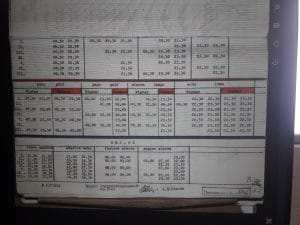
The Tape
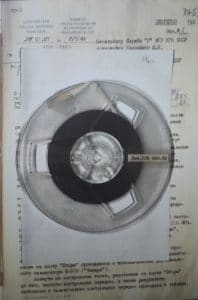
When this author arrived at the KGB archive, his primary objective was to gather some data for his ongoing studies about other nonrelated subjects. The author started to read other agency documents and then found this case. Next followed many hours of reading and photocopying all files that were gathered above with a great sense of astonishment, which increased with the discovery that there was an image of a recorder tape reel. The tape was recorded in February-March 1987 and as the document stated it was added for further information for operational personnel about Western adversary one-directional broadcasts. The note on tape added to the case stated “17.03.87” however it seems the stations in it were from 1986.[79]
The content of the tape was an instruction on what are the one-directional messages and with few samples in the German language and with RTTY[3] symbols.
Re-recording from archive room in the audio link bellow
The transcript of the message is as follows:
One-way radio transmissions are broadcasted on 2 or 3 frequencies simultaneously, based upon a set schedule. The following is an example of a German-language radio transmission by the US intelligence center based in Frankfurt.
For 10 minutes, the announcer says a 3-digit callsign 3 times, and a sequence of numbers from 1 to 0
Caption: [319 | 1234567890]
10 tonal signals that mean “Attention” are played in front of an encoded message.
Caption: [319 1234567890 | 10 tones ]
The number of encoded text groups is pronounced twice, followed by the encoded text in groups of 5. When the transmission of all groups is complete, the announcer says “Wiederhole”, and the number groups are repeated. Any transmission is finished with the word “Ende”.
Caption: [GRUPPEN: 73 | 465-70 044-54 058-55 845-36 818-55 504-38 488-54]
All 73 groups follow.
The same structure is applied to English language stations.
An example of a BND station in German (which can be identified as G16 – translator)
For 5 minutes, the broadcast plays an interval signal and a 2-letter callsign.
Caption: [ Interval signal | TANGO INDIA]
Then, the announcer reads 3-digit recipient IDs and the number of code groups intended for each recipient.
Caption: [ES FOLGEN MITTEILUNGEN FUER | 618 – 35 Gruppe | 445 – 62 Gruppe]
The station continues with 5-digit code groups:
Caption: [618 35 Gruppe 32346 63620 18805 15799 12886 06797 82713 … 19957 ENDE]
There is a category of enemy intelligence broadcasts that can only be received using a special plug-in device for radio receivers.
Example:
Caption: [RTTY signal]
Tape reeling sound in the end.[80]
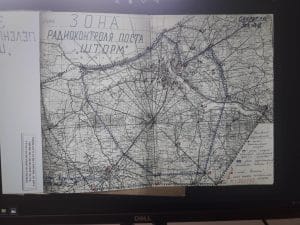
In January 1987 the KGB ordered a maintenance check on the radio listening post “Shtorm” The post was located at the operational hall in RPTS-19 of the Service-R of the Latvian KGB. Its antenna, called Skoverts-KT, was directed to 20 km south-western from the central Riga and was 26 meters high placed above ground. The Service R used for its own transmissions the radio transmitter R-863 “Chinara” with 1-3 block discone antenna made by AFU “Gnezdo”. The signal was tested at 55 locations in Riga, on 3 frequencies 294 MHz, 306 MHz, and 316 MHz, the two navigational signal tracking devices E-512 (Chinara).[81]
Based on the reception tests the maps were drawn and tables made to test the quality of the signal tracker. And with that, the case abruptly ended.
Another smaller case in Latvian KGB archive mentioning Western intel transmissions was found in the regional section of Saldus, a small regional center in Kurzeme, Western Latvia. Where local counterintelligence management received information about one-directional broadcast times and their designations.[82] The information was sent in 1977 in the same way the Service R started these monitoring efforts in Riga. The reason this information was sent was probably connected to the geographical location of Saldus (central part of Kurzeme) and also because of many top-secret objects in Saldus district like the early warning radar base in Skrunda, the rocket base in Nīgrande and also the space surveillance telescopes further in Ventspils district hidden in Slītere forest. All military and industrial objects in Soviet-occupied Latvia were under the guard of the KGB.
Conclusion
The KGB may have continued monitoring efforts in Latvia until its fall in August 1991, when authorities of the restored Republic of Latvia and national activists stormed the much-hated KGB building in the central part of Riga and to their astonishment found large bags of documents, agent ID cards. For the next 20 years, the Latvian government had apparently no proper idea on how to handle the files. However, KGB did not leave everything behind. Probably the other documents associated with these monitoring efforts were taken to Moscow, were destroyed or might still remain to be found in an archive. It is true that since 1988 the KGB was more concerned about the growing Latvian independence restoration movement, but since the KGB was a large structure and they undoubtedly tied this movement to Western intelligence activities, they still tried to control these broadcasts at least until 1990, when Latvia slide into the chaos of two governments – a restored Republic of Latvia, its own newly founded structures and the old power structures still loyal to Moscow.
In the end, these documents reveal to us the complex world of counterintelligence. All this effort is one of the most concrete proof of radio and coded messages used by intelligence agencies. The KGB foreign intelligence had their own one-directional broadcasts and all major counterintelligence services were likely just as busy listening to them and gathering all information about them. These documents if preserved and available remains to be found and analyzed. The same also applies to counterintelligence agencies in Communist Poland, Hungary, Romania, and East Germany, where the KGB sister organizations monitored the airwaves for Western intelligence broadcasts.
While the KGB efforts as we saw were often very questionable, like eavesdropping on foreign and local radio amateurs, breaking personal correspondence, etc, it was their duty – a coded number broadcast for them was not something creepy, nor entertaining- it meant there was an intelligence operation ongoing against their country. A casual talk between radio amateurs was not always plain casual. If we would take off the ideological views, we must understand that the CIA and other Western agencies had their own goals against the Soviet Union just as Soviet Union had against the US and both were playing a very sophisticated game for supremacy and survival.
Another important aspect we learned from these documents is what actually interests the counterintelligence. First, they are not interested in guessing the content[83] of these messages because they did not have the adversary codebooks. As the metadata is often revealing, when you can’t view the contents of the communication. Their main interest was rather practical – from where they were sent, on what time and day, and to what direction. Then there was guesswork – is the message for training, or is it a diversion or operational. Another important question is the frequency – can it be received on domestic or foreign equipment. All this investigative work, and with cooperation with other branches of the KGB the result – the capture of an agent was eventually achieved. Agents can be captured in many ways – he could be betrayed by a mole in his agency, he can be apprehended after long surveillance, he could make a mistake and unmask himself unintentionally or even turn himself in.
With great respect to the workers of both intelligence and counterintelligence branches, this study was written to show the reality of the world of the “Numbers Stations”, the reality that still goes on for many of the agencies in our current world and reality of intelligence work. This hopefully will be the first of many such studies on intelligence documents and will benefit the radio, intelligence, and counterintelligence history.
Glossary
Mhz, Khz -megahertz, kilohertz, radiofrequency value, for shortwave frequency the kilohertz is mostly used
HF High frequency, also known as “shortwave” frequency range between 1-30 MHz
VHF – very high-frequency range from 30 to 300 MHz
UHF – Ultra High Frequency from 300 MHz to 3 Gigahertz
AM – Amplitude Modulation – modulation technique used mostly for transmitting information via a carrier wave. Most uses are public radio stations on Medium Wave, shortwave, two-way communications, aircraft communications. In Soviet terms, it was called “tonal telegraphic” (A2) mode.
CW – carrier wave modulation – used primarily for sending Morse code transmissions that require very narrow bandwidth for the correct reception of the Morse code broadcasts. Was called tonal (A2) mode by the Soviets.
SSB – Single Side Band modulation – modulation technique that can send the signal with lesser bandwidth and power usage, than AM mode. Used primarily in shortwave bands by radio amateurs, utility stations, and military. Soviet used term “telephone mode” (A3)
USB – LSB -Upper Sideband Lower sideband, sometimes called right and left sideband, a type of SSB modulation where signal uses only one side of the bandwidth. Soviets called it A3j
RTTY – Radioteletype, common digital transmission mode used in shortwave for various uses
SSR – Soviet Socialist Republic
KGB – Committee for State Security (Комитет государственной безопасности), VDK – Valsts Drošības Komiteja in Latvian. The official name of the Soviet secret service since 1954 Soviet Union had no structural separation between civilian, foreign and counterintelligence, and it was responsible also for combating anti-soviet activity, organized crime, and border security. KGB is still the official name for security service in Belarus
CIA – Central Intelligence Agency – United States of America civilian foreign intelligence service established in 1947. Центральное разведывательное управление in Russian, Centrālā Izlūkošanas Pārvalde in Latvian
DIA – Defense Intelligence Agency – military defense agency of the United States, established in 1961. In Russian – Разведывательное управление Министерства обороны США, in Latvian Izlūkošanas Pārvalde ASV Aizsardzības Ministrijā.
BND – Federal Intelligence Agency, in German Bundesnachrichtendienst. Foreign Intelligence agency of the German Federal Republic established in 1956.
Radio center- in intelligence language, covert radio transmission and monitoring site belonging to the intelligence agency
Radio Direction Finding – the measurement of the direction from which a received signal was transmitted.
Radio signal Triangulation – the process of finding and determining the location of the radio signal
LNA – Latvian National Archive (Latvijas Nacionālais arhīvs) the chief authority over all state archives in Latvia
LVA – Latvijas Valsts Arhīvs, Latvian State Archive, subdivision of the LNA, holds documents starting from 1940.
LVKA – Latvijas Valsts Kinofotodokumentu arhīvs, a subdivision of LNA responsible for preserving and digitizing cinema and audio documents
References and Sources
[1] The author Māris Goldmanis, a masters degree historian from the University of Latvia, works in fields about national and religious minorities, as well as in the field of intelligence history.
[2] Goldmanis.Māris EXPLAINING THE ‘MYSTERY’ OF NUMBERS STATIONS https://warontherocks.com/2018/05/explaining-the-mystery-of-numbers-stations/
[3] Goldmanis,Māris https://www.numbers-stations.com/articles/fbi-operation-solo-numbers-stations-revealed/
[4] The Game: KGB against CIA and SIS in the Baltic States 1945-1956 https://www.numbers-stations.com/articles/the-game-kgb-against-cia-and-sis-in-the-baltic-states-1945-1956 /// KGB Archive Case Lursens-S (in Latvian) http://www.historia.lv/dokumenti/arhiva-lieta-lursens-s-lpsr-vdk-operativa-spele-ar-anglu-izlukdienestu-no-1948gada-lidz
//CIA FOIA Operation Tilestone documents: http://www.foia.cia.gov/search/site/tilestone?solrsort=sort_label%20asc
//Lucas, Edward. (2012) Deception. Spies, Lies and How Russia Dupes the West. London.Bloomsbury
[5]Kara-Murza,Vladimir,. Latvia opens its KGB archives — while Russia continues to whitewash its past https://www.washingtonpost.com/opinions/2019/01/09/latvia-opens-its-kgb-archives-while-russia-continues-whitewash-its-past
[6] Ongoing parael work of the author is the book about history of the Jewish minority in Krustpils and Jēkabpils http://www.bdaugava.lv/zinas/top-gramata-par-krustpils-un-jekabpils-ebreju-vesturi/
[7] Museum Jews in Latvia http://jewishmuseum.lv/
[8] LNA LVA 1. F. 2.apr. 51. L. Pretinieka aģentūras meklēšana radiosakaru kanālos. 1. sējums . Vadošie norādījumi un dokumenti. (reference according to Latvian official archival reference instructions)
[9] Evgeni Grigorievich Kravchenko born in 1926 in Luhansk, Ukrainian SSR, served KGB in Ukraine since 1959 in regional departments in Luhansk, Chernovo and Donetsk and Chelyabinsk in Russia. Since 1974 served in Riga, Latvian SSR. From 1981 to 1987 served in KGB filial in GFR. In 1987 moved back to Ukraine, after 1992 in Ukrainian security reserve. http://shieldandsword.mozohin.ru/personnel/kravchenko_e_g.htm
[10] LNA LVA 1.f.2.apr. 51.l 5.lp
[11] Bar-Zohar, Mishal Nissim. Mossad. The Greatest missions of the Israeli Secret Service. Harper Collins. New York. 2014, p. 131-156.
[12] Bruno, Jakovičs Šteibriks born in Talsi, Latvia 1932. Associated with KGB since 1951. In 1983 became Minister of Interior Affairs of Latvian SSR. In 1984 moved to Moscow Chief Authority of Investigation of Organized Crime. In 1986 again appointed as Minister of Interior affairs for Latvian SS. Served till 1987.
https://www.lu.lv/fileadmin/user_upload/lu_portal/projekti/vdkkomisija/008_Jarinovska_2017-03-22marts_BrunoSteinbriks.pdf
[13] LNA LVA 1.f.2.apr 51. 7.lp
[14] LNA LVA 1.f.2.apr 51. 8.lp
[15] Longins Ivanovičs Avdjukevičs, born in Vitebsk 1916, Belarusian SSR, lived in Latvia before the World War II, in 1940 served in Latvian Communist Party as commissar of nationalized enterprises, during the war took part in Soviet partisan warfare in eastern Latvia. After the war he served in communist parties in regions in Eastern Latvia, served KGB from 1955, from 1963 to 1980 chief of Latvian KGB. In 1980 retired. http://shieldandsword.mozohin.ru/personnel/avdyukevich_l_i.htm
[16] LNA LVA 1.f.2.apr 51. 10.lp
[17] LNA LVA 1.f.2.apr 51. 11.lp
[18] LNA LVA 1.f.2.apr 51.14.lp
[19] ДОСААФ России официальный сайт Official site of the DOSAAF
[20] LNA LVA 1.f.2.apr 51.16.lp
[21] Understanding Single Sideband (SSB) https://hamradioschool.com/understanding-single-sideband-ssb-2/
[22] LNA LVA 1.f.2.apr 51.17.lp
[23] LNA LVA 1.f.2.apr 51.18.lp
[24] LNA LVA 1.f.2.apr 51.21.lp
[25] Same above
[26] Māris Goldmanis. Before Enigma: The Early Numbers Stations Monitors https://www.numbers-stations.com/articles/before-enigma-the-early-numbers-stations-monitors/
[27] Presumably encoded month number
[28] LNA LVA 1.f.2.apr 51.23
[29] LNA LVA 1.f.2.apr 51.23.lp
[30] LNA LVA 1.f.2.apr 51.24-25.lp
[31] LNA LVA 1.f.2.apr 51.25.lp
[32] LNA LVA 1.f.2.apr 51.26.lp
[33] Same above
[34] LNA LVA 1.f.2.apr 51.27.lp
[35] LNA LVA 1.f.2.apr 51.29.lp
[36] LNA LVA 1.f.2.apr 51.29.lp
[37] LNA LVA 1.f.2.apr 51.31.lp
[38] LNA LVA 1.f.2.apr 51. 42.lp.
[39] Радиоприемники Р-359 https://military.trcvr.ru/2015/08/15/radiopriemnik-r-359-pelikan/
[40] LNA LVA 1.f.2.apr 51. 44.lp.
[41] LNA LVA 1.f.2.apr 51. L. 48-49.lp.
[42] LNA LVA 1.f.2.apr 51. L. 50.lp.
[43] LNA LVA 1.f.2.apr 51. L. 51.lp.
[44] LNA LVA 1.f.2.apr 51. L 59.lp.
[45] LNA LVA 1.f.2.apr 51. L 60-62.lp.
[46] LNA LVA 1.f.2.apr 51. L. 64.lp.
[47] LNA LVA 1.f.2.apr 51. L. 68.lp.
[48] LNA LVA 1.f.2.apr 51. L. 71.lp.
[49] LNA LVA 1.f.2.apr 51. L.. 75.lp.
[50] LNA LVA 1.f.2.apr 51. L.. 80.lp
[51] LNA LVA 1.f.2.apr 51. L.81.lp.
[52] LNA LVA 1.f.2.apr 51. L. 86.
[53] LNA LVA 1.f.2.apr 51. L. 87.lp.
[54] LNA LVA 1.f.2.apr 51. L. 88.lp.
[55] LNA LVA 1.f.2.apr 51. L. 89.lp.
[56] LNA LVA 1.f.2.apr 51. L. 91.lp.
[57] LNA LVA 1.f.2.apr 51. L. 93.lp.
[58] LNA LVA 1.f.2.apr 51. L. 93.lp
[59] It seems that KGB made their designations based on the location of the radio centers. The WFF was meant for Frankfurt, while AF seems was for stations from Athens that Latvian KGB counterintelligence did not follow and therefore more information on AF group stations should be found in other former Soviet republic archives.
[60] LNA LVA 1.f.2.apr 51. L. 94.lp
[61] LNA LVA 1.f.2.apr 51. L. 95.lp.
[62] LNA LVA 1.f.2.apr 51. L. 96.lp.
[63] LNA LVA 1.f.2.apr 51. l. 98 lp.
[64] LNA LVA 1.f.2.apr 51. l. 99.lp.
[65] LNA LVA 1.f.2.apr 51. l..103.lp. Daylight savings were carried out in Soviet Union, contrary to Russia
[66] LNA LVA 1.f.2.apr 51. l.103.lp.
[67] LNA LVA 1.f.2.apr 51. . 105.lp.
[68] LNA LVA 1.f.2.apr 51. l. 108.lp.
[69] LNA LVA 1.f.2.apr.51. L. 109.lp.
[70] LNA LVA 1.f.2.apr 51. L. 122.lp.
[71] LNA LVA 1.f.2.apr 51. l.. 122.lp.
[72] LNA LVA 1.f.2.apr 51. l.. 126-150.lp.
[73] “Звездные войны”, которых не было. http://www.buran.ru/htm/str163.htm[74] LNA LVA 1.f.2.apr 51. l.. 152.lp.
[75] LNA LVA 1.f.2.apr 51. L.160.lp.
[76] LNA LVA 1.f.2.apr 51. L.. 163.lp.
[77] LNA LVA 1.f.2.apr 51.l. 171. Lp.
[78] LNA LVA 1.f.2.apr 51.l. 171.lp.
[79] LNA LVA 1.f.2.apr 51.l. 175.lp.
[80] LNA LVA 1. F. 2.apr. 51. L. 176.a.
[81] LNA LVA 1. F. 2.apr. 51. L. 177.lp.
[82] LNA LVA 1. F. 18.apr. 1. L. Pretilzūkošana. 2. Daļas darba virzienos. 1. Sējums-vadošie materiāli.
[83]Szoldra, Paul Leaked NSA document says metadata collection is one of agency’s ‘most useful tools’ https://www.businessinsider.com/nsa-document-metadata-2016-12?r=US&IR=T

